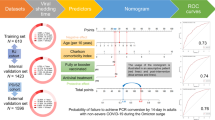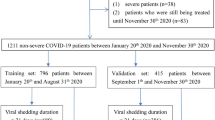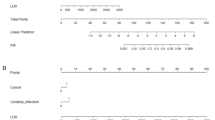Abstract
With the number of cases of coronavirus disease-2019 (COVID-19) increasing rapidly, the World Health Organization (WHO) has recommended that patients with mild or moderate symptoms could be released from quarantine without nucleic acid retesting, and self-isolate in the community. This may pose a potential virus transmission risk. We aimed to develop a nomogram to predict the duration of viral shedding for individual COVID-19 patients. This retrospective multicentric study enrolled 135 patients as a training cohort and 102 patients as a validation cohort. Significant factors associated with the duration of viral shedding were identified by multivariate Cox modeling in the training cohort and combined to develop a nomogram to predict the probability of viral shedding at 9, 13, 17, and 21 d after admission. The nomogram was validated in the validation cohort and evaluated by concordance index (C-index), area under the curve (AUC), and calibration curve. A higher absolute lymphocyte count (P=0.001) and lymphocyte-to-monocyte ratio (P=0.013) were correlated with a shorter duration of viral shedding, while a longer activated partial thromboplastin time (P=0.007) prolonged the viral shedding duration. The C-indices of the nomogram were 0.732 (95% confidence interval (CI): 0.685–0.777) in the training cohort and 0.703 (95% CI: 0.642–0.764) in the validation cohort. The AUC showed a good discriminative ability (training cohort: 0.879, 0.762, 0.738, and 0.715 for 9, 13, 17, and 21 d; validation cohort: 0.855, 0.758, 0.728, and 0.706 for 9, 13, 17, and 21 d), and calibration curves were consistent between outcomes and predictions in both cohorts. A predictive nomogram for viral shedding duration based on three easily accessible factors was developed to help estimate appropriate self-isolation time for patients with mild or moderate symptoms, and to control virus transmission.
摘要
目的
探索与新型冠状病毒核酸转阴时长相关的因素, 并建立一个模型来预测病毒核酸转阴的概率。
创新点
本研究根据影响非重症新型冠状病毒肺炎 (COVID-19) 患者病毒核酸转阴时长的因素建立一个模型来预测病毒核酸转阴的概率, 从而估计非重症COVID-19患者的隔离时长。
方法
本研究采用多中心回顾性研究方法, 选取浙江省四所医院的135例患者作为训练队列和另一家医院的102名患者作为验证队列。在训练队列中, 使用多因素Cox回归模型确定与病毒核酸转阴时长相关的重要预测因素, 并以此为基础构建一个列线图来预测病毒在第9、13、17和21天转阴的概率。验证队列用于验证列线图, 并通过C指数、曲线下面积 (AUC) 和校准曲线来评估列线图的效能。
结论
训练队列中发现, 基线淋巴细胞绝对计数和淋巴单核细胞比值越高, 病毒的核酸转阴时长越短; 而基线的活化部分凝血酶时间越长, 病毒的核酸转阴时长越长。列线图在训练和验证队列中的C指数分别为0.732和0.703。AUC表现出较好的区分度。校准曲线展示了实际结果和预测之间具有较好的一致性。本研究确定了与病毒核酸转阴时长相关的三个因素, 并构建一个列线图来预测病毒核酸转阴的概率, 这有助于估计每个非重症COVID-19患者的隔离时长, 并控制病毒传播。
Article PDF
Similar content being viewed by others
Explore related subjects
Discover the latest articles and news from researchers in related subjects, suggested using machine learning.Avoid common mistakes on your manuscript.
References
Bullard J, Dust K, Funk D, et al., 2020. Predicting infectious severe acute respiratory syndrome coronavirus 2 from diagnostic samples. Clin Infect Dis, 71(10):2663–2666. https://doi.org/10.1093/cid/ciaa638
Chen RC, Liang WH, Jiang M, et al., 2020. Risk factors of fatal outcome in hospitalized subjects with coronavirus disease 2019 from a nationwide analysis in China. Chest, 158(1):97–105. https://doi.org/10.1016/j.chest.2020.04.010
DeLong ER, DeLong DM, Clarke-Pearson DL, 1988. Comparing the areas under two or more correlated receiver operating characteristic curves: a nonparametric approach. Biometrics, 44(3):837–845. https://doi.org/10.2307/2531595
Epidemiology Working Group for NCIP Epidemic Response, Chinese Center for Disease Control and Prevention, 2020. The epidemiological characteristics of an outbreak of 2019 novel coronavirus diseases (COVID-19) in China. Chin J Epidemiol, 41(2): 145–151 (in Chinese). https://doi.org/10.3760/crnaj.issn.0254-6450.2020.02.003
Giannis D, Ziogas IA, Gianni P, 2020. Coagulation disorders in coronavirus infected patients: COVID-19, SARS-CoV-1, MERS-CoV and lessons from the past. J Clin Virol, 127: 104362. https://doi.org/10.1016/j.jcv.2020.104362
Guan WJ, Ni ZY, Hu Y, et al., 2020. Clinical characteristics of coronavirus disease 2019 in China. N Engl J Med, 382(18): 1708–1720. https://doi.org/10.1056/NEJMoa2002032
Henry BM, de Oliveira MHS, Benoit S, et al., 2020. Hematologic, biochemical and immune biomarker abnormalities associated with severe illness and mortality in coronavirus disease 2019 (COVID-19): a meta-analysis. Clin Chem Lab Med, 58(7):1021–1028. https://doi.org/10.1515/cclm-2020-0369
Li G, Fan YH, Lai YN, et al., 2020. Coronavirus infections and immune responses. J Med Virol, 92(4):424–432. https://doi.org/10.1002/jmv.25685
Li LZ, Zhang BH, He B, et al., 2020. Critical patients with coronavirus disease 2019: risk factors and outcome nomogram. J Infect, 80(6):e37–e38. https://doi.org/10.1016/j.jinf.2020.03.025
Li Q, Guan XH, Wu P, et al., 2020. Early transmission dynamics in Wuhan, China, of novel coronavirus-infected pneumonia. N Engl J Med, 382(13):1199–1207. https://doi.org/10.1056/NEJMoa2001316
Lian JS, Cai H, Hao SR, et al., 2020. Comparison of epidemiological and clinical characteristics of COVID-19 patients with and without Wuhan exposure history in Zhejiang Province, China. J Zhejiang Univ-Sci B (Biomed & Biotechnol), 21(5):369–377. https://doi.org/10.1631/jzus.B2000112
Liang WH, Liang HR, Ou LM, et al., 2020. Development and validation of a clinical risk score to predict the occurrence of critical illness in hospitalized patients with COVID-19. JAMA Intern Med, 180(8):1081–1089. https://doi.org/10.1001/jamainternmed.2020.2033
Lin AF, He ZB, Zhang S, et al., 2020. Early risk factors for the duration of severe acute respiratory syndrome coronavirus 2 viral positivity in patients with coronavirus disease 2019. Clin Infect Dis, 71(16):2061–2065. https://doi.org/10.1093/cid/ciaa490
NHC (National Health Commission of the People’s Republic of China), 2020. Clinical diagnosis and treatment guidance of 2019 novel coronavirus (2019-nCoV) caused pneumonia (5th Edition). http://www.nhc.gov.cn/yzygj/s7653p/202002/3b09b894ac9b4204a79db5b8912d4440/files/7260301a393845fc87fcf6dd52965ecb.pdf (in Chinese).
Subramaniam S, Scharrer I, 2018. Procoagulant activity during viral infections. Front Biosci (Landmark Ed), 23:1060–1081. https://doi.org/10.2741/4633
Sun SY, Cai XJ, Wang HG, et al., 2020. Abnormalities of peripheral blood system in patients with COVID-19 in Wenzhou, China. Clin Chim Acta, 507:174–180. https://doi.org/10.1016/j.cca.2020.04.024
Tang N, Li DJ, Wang X, et al., 2020. Abnormal coagulation parameters are associated with poor prognosis in patients with novel coronavirus pneumonia. J Thromb Haemost, 18(4):844–847. https://doi.org/10.1111/jth.14768
WHO (World Health Organization), 2020a. Clinical management of COVID-19: interim guidance. https://www.who.int/publications/i/item/clinical-management-of-covid-19
WHO, 2020b. Coronavirus disease (COVID-19): situation reports-209. https://www.who.int/docs/default-source/coronaviruse/situation-reports/20200816-covid-19-sitrep-209.pdf?sfvrsn=5dde1ca2_2
WHO, 2020c. Criteria for releasing COVID-19 patients from isolation. https://www.who.int/news-room/commentaries/detail/criteria-for-releasing-covid-19-patients-from-isolation
WHO, 2020d. Laboratory testing of human suspected cases of novel coronavirus (nCoV) infection: interim guidance. https://apps.who.int/iris/bitstream/handle/10665/330374/WHO-2019-nCoV-laboratory-2020.1-eng.pdf
Wölfel R, Corman VM, Guggemos W, et al., 2020. Virological assessment of hospitalized patients with COVID-2019. Nature, 581(7809):465–469. https://doi.org/10.1038/s41586-020-2196-x
Wu CM, Chen XY, Cai YP, et al., 2020. Risk factors associated with acute respiratory distress syndrome and death in patients with coronavirus disease 2019 pneumonia in Wuhan, China. JAMA Intern Med, 180(7):934–943. https://doi.org/10.1001/jamainternmed.2020.0994
Xiao AT, Tong YX, Zhang S, 2020. Profile of RT-PCR for SARS-CoV-2: a preliminary study from 56 COVID-19 patients. Clin Infect Dis, 71(16):2249–2251. https://doi.org/10.1093/cid/ciaa460
Xu KJ, Chen YF, Yuan J, et al., 2020. Factors associated with prolonged viral RNA shedding in patients with coronavirus disease 2019 (COVID-19). Clin Infect Dis, 71(15):799–806. https://doi.org/10.1093/cid/ciaa351
Yang AP, Liu JP, Tao WQ, et al., 2020. The diagnostic and predictive role of NLR, d-NLR and PLR in COVID-19 patients. Int Immunopharmacol, 84:106504. https://doi.org/10.1016/j.intimp.2020.106504
Yang Y, Shen CG, Li JX, et al., 2020. Plasma IP-10 and MCP-3 levels are highly associated with disease severity and predict the progression of COVID-19. J Allergy Clin Immunol, 146(1):119–127.e4. https://doi.org/10.1016/j.jaci.2020.04.027
Zhao QW, Meng M, Kumar R, et al., 2020. Lymphopenia is associated with severe coronavirus disease 2019 (COVID-19) infections: a systemic review and meta-analysis. Int J Infect Dis, 96:131–135. https://doi.org/10.1016/j.ijid.2020.04.086
Zheng HY, Zhang M, Yang CX, et al., 2020. Elevated exhaustion levels and reduced functional diversity of T cells in peripheral blood may predict severe progression in COVID-19 patients. Cell Mol Immunol, 17(5):541–543. https://doi.org/10.1038/s41423-020-0401-3
Zheng SF, Fan J, Yu F, et al., 2020. Viral load dynamics and disease severity in patients infected with SARS-CoV-2 in Zhejiang province, China, January-March 2020: retrospective cohort study. BMJ, 369:m1443. https://doi.org/10.1136/bmj.m1443
Zhou F, Yu T, Du RH, et al., 2020. Clinical course and risk factors for mortality of adult inpatients with COVID-19 in Wuhan, China: a retrospective cohort study. Lancet, 395(10229):1054–1062. https://doi.org/10.1016/S0140-6736(20)30566-3
Zhou YG, Fu BQ, Zheng XH, et al., 2020. Pathogenic T-cells and inflammatory monocytes incite inflammatory storms in severe COVID-19 patients. Nat Sci Rev, 7(6):998–1002. https://doi.org/10.1093/nsr/nwaa041
Zhou Z, Ren LL, Zhang L, et al., 2020. Overly exuberant innate immune response to SARS-CoV-2 infection. SSRN, in press. https://doi.org/10.2139/ssrn.3551623
Zhu N, Zhang DY, Wang WL, et al., 2020. A novel coronavirus from patients with pneumonia in China, 2019. N Engl J Med, 382(8):727–733. https://doi.org/10.1056/NEJMoa2001017
Zou L, Ruan F, Huang M, et al., 2020. SARS-CoV-2 viral load in upper respiratory specimens of infected patients. N Engl J Med, 382(12):1177–1179. https://doi.org/10.1056/NEJMc2001737
Acknowledgments
This research was supported by the Medical and Health Science and Technology Project of Zhejiang Province, China (No. 2018KY116). We would like to acknowledge Dr. Yuzhen GAO and Dr. Yanzhong WANG (Department of Clinical Laboratory, Sir Run Run Shaw Hospital, Zhejiang University School of Medicine, Hangzhou, China) for their writing assistance and proofreading the article.
Author information
Authors and Affiliations
Corresponding authors
Additional information
Author contributions
Jun ZHANG and Xinyou XIE designed the study and reviewed the manuscript prior to submission. Shijin YUAN coordinated the work and took the lead in drafting the manuscript and interpreting. Yong PAN and Yan XIA developed the statistical methods. Yong PAN, Jiangnan CHEN, Yan ZHANG, Wei ZHENG, and Xiaoping XU participated in the collection of experimental data. The corresponding author attests that all listed authors met authorship criteria and that no others meeting the criteria have been omitted. All authors have read and approved the final manuscript and, therefore, have full access to all the data in the study and take responsibility for the integrity and security of the data.
Compliance with ethics guidelines
Shijin YUAN, Yong PAN, Yan XIA, Yan ZHANG, Jiangnan CHEN, Wei ZHENG, Xiaoping XU, Xinyou XIE, and Jun ZHANG declare that they have no conflict of interest.
This study was approved by the Institutional Ethics Committee of Sir Run Run Shaw Hospital, Hangzhou, China (No. Scientific Research 20200331-45). All procedures followed were in accordance with the ethical standards of the responsible committee on human experimentation (institutional and national) and with the Helsinki Declaration of 1975, as revised in 2008 (5). Informed consent was waived due to retrospective nature of the study.
Rights and permissions
About this article
Cite this article
Yuan, S., Pan, Y., Xia, Y. et al. Development and validation of an individualized nomogram for early prediction of the duration of SARS-CoV-2 shedding in COVID-19 patients with non-severe disease. J. Zhejiang Univ. Sci. B 22, 318–329 (2021). https://doi.org/10.1631/jzus.B2000608
Received:
Accepted:
Published:
Issue Date:
DOI: https://doi.org/10.1631/jzus.B2000608
Key words
- Coronavirus disease-2019 (COVID-19)
- Severe acute respiratory syndrome coronavirus 2 (SARS-CoV-2)
- Duration of viral shedding
- Nomogram




